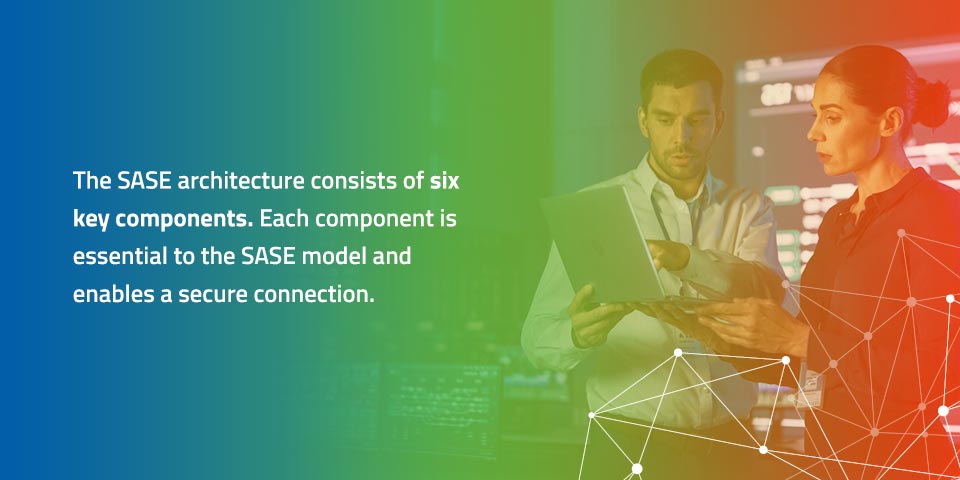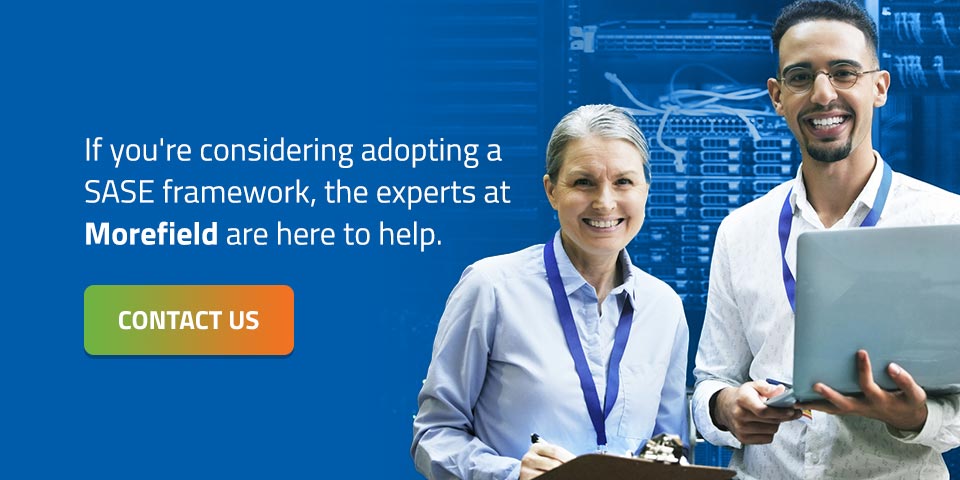[4 min. read]
Secure access service edge (SASE) is helpful for many companies considering digital transformation. If you’re looking for a way to upgrade your network security, SASE may be right for your organization.
This post will define SASE, explain how it works and detail the benefits it can bring your company.
What Is SASE?
Experts simply define SASE as a cloud-native security framework that blends wide area network (WAN) features with cloud security technologies to build secure connections between users and your internal network.
SASE — pronounced like “sassy” — combines various network security technologies into one comprehensive solution. This solution enables more efficient remote work and simplifies your tech stack, key steps toward a successful digital transformation.
It’s important to distinguish SASE from other forms of edge computing. SASE is often mistaken for security service edge (SSE), which is a SASE subcategory that focuses on security services.
How Does SASE Work?
SASE works by inspecting user traffic at a security enforcement point near them, which shifts the focus off your data center and onto your users. This change makes connecting to your applications and services safer and more efficient.
Rather than forwarding web traffic all the way to your data center and back, SASE sends user connections to a nearby enforcement point for inspection. Once approved, the user can securely connect to the destination.
In contrast, legacy system security checks take place in on-premises firewall hardware. While this model works well for in-house teams, it’s inefficient for remote and distributed users. And as people begin working from home more often, companies must find new ways to improve the remote user experience to stay competitive.
Essentially, SASE checks your user or system where they are instead of waiting for their connection to reach your network.
Breaking Down the SASE Model
The SASE architecture consists of six key components. Each component is essential to the SASE model and enables a secure connection.
1. Software-Defined Wide Area Network (SD-WAN)
An SD-WAN network is an overlay network, which means that it is constructed on top of another network’s infrastructure. This virtual architecture eliminates the constraints of a physical network, which allows it to provide extra networking flexibility and optimize the user experience.
In SASE, the SD-WAN maps the most efficient route to the destination data center, cloud application or internet server from the user’s device. This function enables you to quickly deploy new applications and services while managing uniform policy across various locations.
2. Secure Web Gateway (SWG)
As the intermediate stop between your users and your network, the SWG prevents unsecured access to your network. When users attempt to access your applications, the SWG inspects their requests against your company policy to prevent malicious entities from reaching your internal network.
This boundary shields both your users and your network from cyber threats such as web-transmitted viruses, vulnerable websites and malware.
3. Cloud Access Security Broker (CASB)
A CASB is a cloud-based security enforcement point located between your users and your network that ensures safe access to your internal applications and services. It also works for any SaaS applications you use.
CASBs include various types of enforcement, including:
- Single sign-on (SSO)
- Tokenization
- Encryption
- Device profiling
- Credential mapping
- Malware detection
- Logging
4. Firewall as a Service (FWaaS)
A FWaaS solution replaces physical firewall hardware with a cloud-based version. These solutions provide your network with advanced next-generation firewall (NGFW) capabilities and access controls such as:
- Advanced threat protection
- Domain name system (DNS) security
- URL filtering
- Intrusion prevention systems (IPS)
5. Zero Trust Network Access (ZTNA)
ZTNA is a critical part of SASE architecture. As the name implies, it does not trust any user — the ZTNA framework requires constant authorization, authentication and validation of all users before granting access to any of your applications or data.
This framework enables remote users to connect securely to your applications without needing to be on your network, which protects them from exposure to the internet at large.
6. Centralized Management
The ability to manage all these components from one central console streamlines your tech stack and improves visibility, eliminating many of the challenges that come with legacy architecture. A unified management console also enables you to deliver consistent connectivity across your organization regardless of your users’ physical locations.
Pros and Cons of SASE
Understanding the potential benefits and downsides of SASE architecture can help you determine whether it is a good fit for your company.
Benefits of SASE
Here are some of the primary benefits of implementing a SASE framework:
- Simplified networks: Unlike virtual private networks (VPNs), SASE solutions do not require users to download additional software to connect to your network. This simplifies the connection process and reduces your IT costs.
- Reduced cybersecurity costs: When you can streamline your tech stack, you can save money on security solutions. For example, a FWaaS eliminates the need for physical firewall hardware, expanding your security system’s reach and reducing infrastructure costs.
- Seamless user experience: As a cloud-based solution, SASE manages connections at key exchange points in real-time. This capability optimizes connections and minimizes latency, providing a superior user experience to VPNs. This is especially true for multi-cloud environments.
- Decreased risk: SASE is a cloud-native framework, so it’s more capable of addressing new challenges as computing becomes increasingly distributed.
- Scalability: Cloud-native solutions are highly scalable, so they can quickly scale to meet increasing demand as your business grows.
Cons of SASE
As with any technological solution, other solutions fit certain use cases better than SASE. Here are some examples:
- Complex integration: If you plan to use tools from multiple different manufacturers, trying to connect them all under the SASE umbrella can introduce new complexities into the system.
- New technology: Because the SASE framework is fairly new, some of its components are still developing. Some companies find themselves running into unexpected limitations in certain areas. For example, SASE can only integrate existing technologies at the moment.
- Limited IT options: Because SASE creates a unified solution, it limits a company’s ability to source solutions from multiple vendors, which may be a disadvantage for some organizations.
- Learning curve: Implementing a SASE framework may require you to reskill or upskill your existing IT team, which can cost you significant effort, money and time up front.
Discussing your needs with a well-established IT consulting firm can help you determine whether SASE is right for your company.
Contact Morefield for More Information
SASE can help drive your business toward digital transformation and simplify your security tech stack when implemented properly. If you’re considering adopting a SASE framework, the experts at Morefield are here to help.
We help organizations in various industries integrate and enhance their technology to boost productivity and efficiency. Whether you’re looking for an individual product to add to your existing system or a fully integrated solution, we can help you find the right technologies to meet your organization’s unique needs.
With more than 70 years of experience in IT, you can count on Morefield to provide unparalleled service and expertise. Contact our team today for more information about our technology services.


